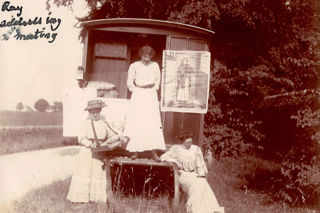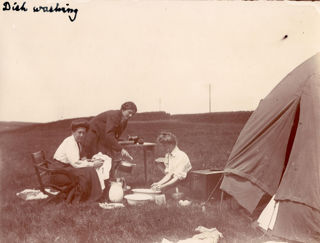
Touring for the Cause – Ray Costelloe and the NUWSS
05 April 2018
In 1908 the suffrage movement took to the road by caravan, combining business with pleasure, enabling the women to enjoy the novelty of the increasingly popular horse-drawn caravan holiday while reaching new supporters.
Meet Ray Costelloe and her fellow female students from Cambridge University.
In 1908 the suffrage movement first took to the road by caravan, seeking new ways to spread the message of the campaign for votes for women beyond major towns and cities. One of these tours was taken by a group of female Cambridge Students representing the non-militant National Union of Women’s Suffrage Societies (NUWSS). Here we discover the story of their tour.

The Women’s Library at the London School of Economics is home to a wealth of material telling the story of the suffrage campaign. Their incredible archive contains the personal letters of feminist campaigner and writer Rachel ‘Ray’ Strachey (neé Costelloe). They contained a charming daily correspondence with her family, penned during a caravan tour taken by Ray in 1908. Representing the non-militant suffrage organisation, the NUWSS, Ray and a party of fellow female students from Newnham College, Cambridge University, set out on a huge adventure from Scotland to Oxford during their summer holiday. Not only do the letters include detail of her work to spread the word of the campaign to gain votes for women, but they also provide an extremely rare first-hand insight into life on the open road during this period.
This caravan tour would combine both business with pleasure, enabling the women to enjoy the novelty of the increasingly popular horse-drawn caravan holiday while reaching new supporters. Joining Ray included her good friend Ellie Rendel, the granddaughter of prolific suffragist and NUWSS committee member Lady Strachey. For Ray Costelloe, this connection with the Strachey’s was to prove life-long. She became close friends with Ellie’s aunt Pippa, Secretary of the NUWSS, and would later marry her brother Oliver.

The group represented an organisation which used the mode of peaceful persuasion rather than the militant and sometimes unlawful operations of the ‘suffragettes’. The main point of argument for these NUWSS members was that working women contributed taxes, so why were they not given a say on how these taxes were spent? That they contributed to the workforce, so why were they ignored when legislation was passed which affected their working conditions? Indeed, like all women at the time this group of suffragist caravanners faced many inequalities based on their sex. As female Cambridge students they were able to attend lectures, but they were prohibited from gaining a degree at the end of their study like male contemporaries.
In early July the party set out on the tour starting at Beattock on the Scottish Borders weaving their way through town and country to reach their destination of Oxford. At most locations they were met with great friendliness, filling marketplaces with hundreds of locals and reporters. At only a few halts did they report disturbance, instead they were frequently greeted by ardent supporters of the cause who offered shelter, meals and hot baths. In some areas such as Ambleside, the group sparked such enthusiasm that local branches were formed as a result of their visit.
For Ray and her party their peaceful approach to campaigning, which was in great contrast to the militant tactics of the Women’s Social and Political Union (WSPU), met much positivity. In Kendal, reporters from the Mercury & Times were clearly surprised when the women failed to live up to the stereotype given to many suffrage campaigners: ‘there was nothing of the wild hysterical style about them. They all spoke clearly and evidently in earnest.’ While at Maryport Ray even wrote that: ‘the police were charming, and all in favour most enthusiastically’. This was in stark contrast to the increasingly hostile relationship between the authorities and militant suffrage activities.

The caravan itself which was given the name ‘Eva’, proved to be a huge draw of crowds.
Ray commented: ‘The van is a great attraction, and helps us to collect our audiences. It gets much admiration and attention, and when it is covered with posters and planted in the middle of a market-place it is a really wonderful sight. We speak from the front which is a very good platform.’
When taking time off from campaigning, these first time caravanners fell quite in love with the hobby itself. Ray wrote of idyllic camp sites in buttercup fields, and purchasing milk and eggs fresh from the local farmer as was the practice of pioneer caravanners on tour. The only challenge they faced was the weather, once having to retire to an inn after all bedding became wet. Also, the practicalities of cooking and cleaning on tour proved tedious for this group of women probably unused to doing daily chores: ‘Our cooking gets less and less – partly because it is such a bore to wash up, and partly because it takes so long, as our stove takes ¾ of an hour to boil water.’
The tour ended in Oxford at the end of July where Ray was met by her Aunt, the Hon Mrs Bertrand Russell of the Oxford Women’s Suffrage Society who presided over the meeting. This caravan tour was deemed as such a success by the NUWSS that in August another party of women travelled through Yorkshire, using the same campaigning methods as Ray and her group.
For Ray, a lifetime of feminist politics lay ahead of her, writing and campaigning tirelessly until her death in 1940. After women gained the right to vote for the first time in 1918 she stood unsuccessfully as a candidate for Bromford and Bow at subsequent elections, and later became the Parliamentary Secretary for the first British female MP Nancy Astor.

Subscribe for updates
Get our latest news and events straight to your inbox.